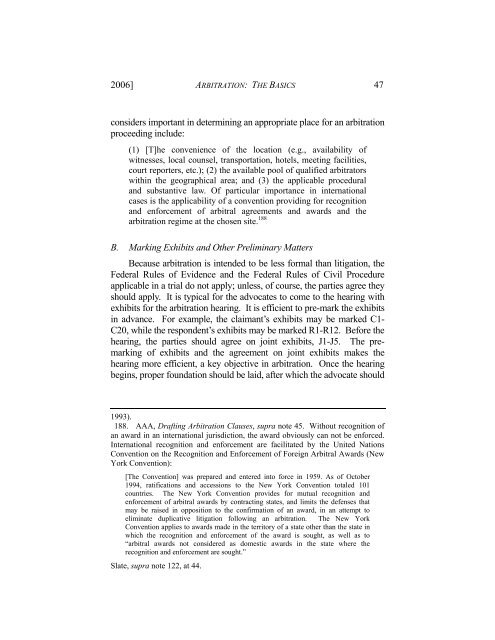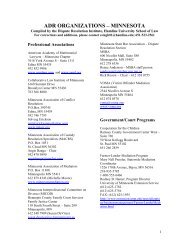2006/Vol. 5 No.1 - Hamline Law - Hamline University
2006/Vol. 5 No.1 - Hamline Law - Hamline University
2006/Vol. 5 No.1 - Hamline Law - Hamline University
Create successful ePaper yourself
Turn your PDF publications into a flip-book with our unique Google optimized e-Paper software.
<strong>2006</strong>] ARBITRATION: THE BASICS 47<br />
considers important in determining an appropriate place for an arbitration<br />
proceeding include:<br />
(1) [T]he convenience of the location (e.g., availability of<br />
witnesses, local counsel, transportation, hotels, meeting facilities,<br />
court reporters, etc.); (2) the available pool of qualified arbitrators<br />
within the geographical area; and (3) the applicable procedural<br />
and substantive law. Of particular importance in international<br />
cases is the applicability of a convention providing for recognition<br />
and enforcement of arbitral agreements and awards and the<br />
arbitration regime at the chosen site. 188<br />
B. Marking Exhibits and Other Preliminary Matters<br />
Because arbitration is intended to be less formal than litigation, the<br />
Federal Rules of Evidence and the Federal Rules of Civil Procedure<br />
applicable in a trial do not apply; unless, of course, the parties agree they<br />
should apply. It is typical for the advocates to come to the hearing with<br />
exhibits for the arbitration hearing. It is efficient to pre-mark the exhibits<br />
in advance. For example, the claimant’s exhibits may be marked C1-<br />
C20, while the respondent’s exhibits may be marked R1-R12. Before the<br />
hearing, the parties should agree on joint exhibits, J1-J5. The premarking<br />
of exhibits and the agreement on joint exhibits makes the<br />
hearing more efficient, a key objective in arbitration. Once the hearing<br />
begins, proper foundation should be laid, after which the advocate should<br />
1993).<br />
188. AAA, Drafting Arbitration Clauses, supra note 45. Without recognition of<br />
an award in an international jurisdiction, the award obviously can not be enforced.<br />
International recognition and enforcement are facilitated by the United Nations<br />
Convention on the Recognition and Enforcement of Foreign Arbitral Awards (New<br />
York Convention):<br />
[The Convention] was prepared and entered into force in 1959. As of October<br />
1994, ratifications and accessions to the New York Convention totaled 101<br />
countries. The New York Convention provides for mutual recognition and<br />
enforcement of arbitral awards by contracting states, and limits the defenses that<br />
may be raised in opposition to the confirmation of an award, in an attempt to<br />
eliminate duplicative litigation following an arbitration. The New York<br />
Convention applies to awards made in the territory of a state other than the state in<br />
which the recognition and enforcement of the award is sought, as well as to<br />
“arbitral awards not considered as domestic awards in the state where the<br />
recognition and enforcement are sought.”<br />
Slate, supra note 122, at 44.
















